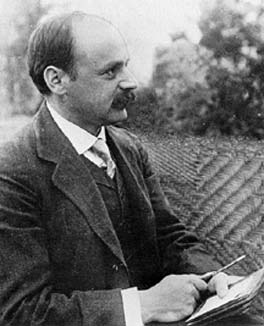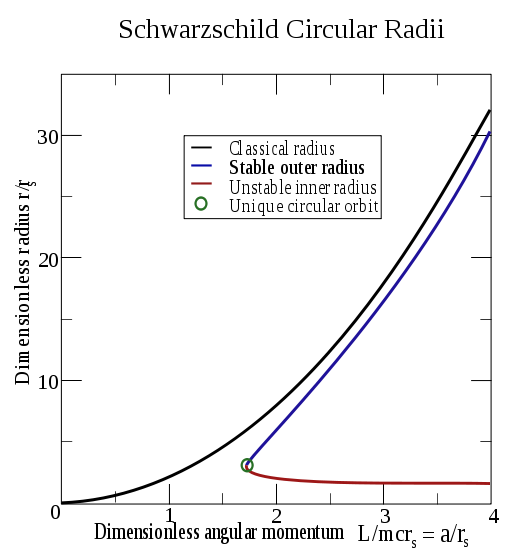<Back to Index>
- Physicist Karl Schwarzschild, 1873
- Painter and Philosopher Nikolai Konstantinovich Rerikh, 1874
- Lieutenant Colonel of the French Army Alfred Dreyfus, 1859
PAGE SPONSOR

Karl Schwarzschild (October 9, 1873 – May 11, 1916) was a German physicist. He is also the father of astrophysicist Martin Schwarzschild.
He is best known for providing the first exact solution to the Einstein field equations of general relativity,
for the limited case of a single spherical non-rotating mass, which he
accomplished in 1915, the same year that Einstein first introduced
general relativity. The Schwarzschild solution, which makes use of Schwarzschild coordinates and the Schwarzschild metric, leads to the well known Schwarzschild radius, which is the size of the event horizon of a non-rotating black hole. Schwarzschild accomplished this triumph while serving in the German army during World War I. He died the following year from pemphigus, a painful autoimmune disease which he developed while at the Russian front. Schwarzschild was born in Frankfurt am Main to Jewish parents. He was something of a child prodigy, having a paper on celestial mechanics published when he was only sixteen. He studied at Strasbourg and Munich, obtaining his doctorate in 1896 for a work on Jules Henri Poincaré's theories. From 1897, he worked as assistant at the Kuffner observatory in Vienna. From 1901 until 1909 he was a professor at the prestigious institute at Göttingen, where he had the opportunity to work with some significant figures including David Hilbert and Hermann Minkowski. Schwarzschild became the director of the observatory in Göttingen. He moved to a post at the Astrophysical Observatory in Potsdam in 1909. From 1912, Schwarzschild was a member of the Prussian Academy of Sciences. At the outbreak of World War I in
1914 he joined the German army despite being over 40 years old. He
served on both the western and eastern fronts, rising to the rank of
lieutenant in the artillery. While serving on the front in Russia in
1915, he began to suffer from a rare and painful skin disease called pemphigus. Nevertheless, he managed to write three outstanding papers, two on relativity theory and one on quantum theory. His papers on relativity produced the first exact solutions to the Einstein field equations, and a minor modification of these results gives the well known solution that now bears his name: the Schwarzschild metric. Schwarzschild's struggle with pemphigus may have eventually led to his death. He died on May 11, 1916. Thousands of dissertations, articles, and books have since been devoted to the study of Schwarzschild's solutions to the Einstein field equations. However, although Schwarzschild's best known work lies in the area of general relativity, his research interests were extremely broad, including work in celestial mechanics, observational stellar photometry, quantum mechanics, instrumental astronomy, stellar structure, stellar statistics, Halley's comet, and spectroscopy. Some of his particular achievements include measurements of variable stars, using photography, and the improvement of optical systems, through the perturbative investigation of geometrical aberrations. While
at Vienna in 1897, Schwarzschild developed a formula to calculate the
optical density of photographic material. It involved an exponent now
known as the Schwarzschild exponent, which is the p in the formula: (where i is optical density of exposed photographic emulsion, a function of I, the intensity of the source being observed, and t, the exposure time, with p a
constant). This formula was important for enabling more accurate
photographic measurements of the intensities of faint astronomical
sources. According to W. Pauli (Theory of relativity), Schwarzschild is the first to introduce the correct Lagrangian formalism of the electromagnetic field as where Einstein himself was pleasantly surprised to learn that the field equations admitted
exact solutions, because of their prima facie complexity, and because
he himself had only produced an approximate solution. Einstein's
approximate solution was given in his famous 1915 article on the
advance of the perihelion of Mercury. There, Einstein used rectangular
coordinates to approximate the gravitational field around a spherically
symmetric, non-rotating, non-charged mass. Schwarzschild, in contrast,
chose a more elegant "polar-like" coordinate system and was able to
produce an exact solution which he first set down in a letter to
Einstein of 22 December 1915, written while Schwarzschild was serving
in the war stationed on the Russian front. Schwarzschild concluded the
letter by writing: "As you see, the war treated me kindly enough, in
spite of the heavy gunfire, to allow me to get away from it all and
take this walk in the land of your ideas." In 1916, Einstein wrote to Schwarzschild on this result: Schwarzschild's
second paper, which gives what is now known as the "Inner Schwarzschild
solution" (in German: "innere Schwarzschild - Lösung"), is valid
within a sphere of homogeneous and isotropic distributed molecules
within a shell of radius r=R. It is applicable to solids;
incompressible fluids; the sun and stars viewed as a quasi - isotropic
heated gas; and any homogeneous and isotropic distributed gas. Schwarzschild's first (spherically symmetric) solution contains a coordinate singularity on
a surface that is now named after him. In Schwarzschild coordinates,
this singularity lies on the sphere of points at a particular radius,
called the Schwarzschild radius: where G is the gravitational constant, M is the mass of the central body, and c is the speed of light in a vacuum. In cases where the radius of the central body is less than the Schwarzschild radius, Rs represents the radius within which all massive bodies, and even photons, must inevitably fall into the central body (ignoring quantum tunnelling effects
near the boundary). When the mass density of this central body exceeds
a particular limit, it triggers a gravitational collapse which, if it
occurs with spherical symmetry, produces what is known as a
Schwarzschild black hole. This occurs, for example, when the mass of a neutron star exceeds the Tolman - Oppenheimer - Volkoff limit (about three solar masses).


 are the electric and magnetic field,
are the electric and magnetic field,  is the vector potential and φ is the electric potential.
is the vector potential and φ is the electric potential.


